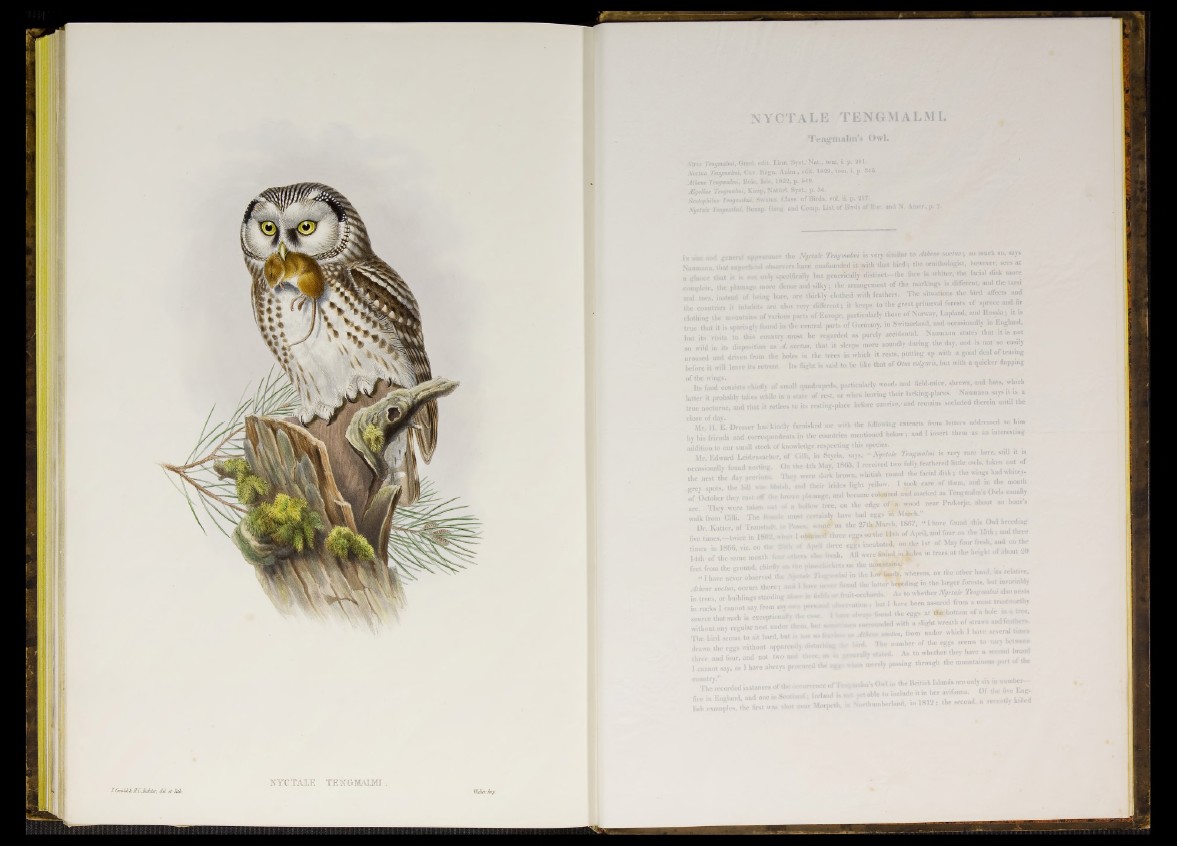
J. Gculd/SuÆCJRuhter, del et m
BTC TAIE TENGMALMI.
Walter Imp
• Tengmalmi
»tbed with feathers. The situations the bird affects and
■. keeps to the great primeval forests of spruce and fir
e, particularly those of Norway, Lapland, and Russia ; it is
s 0f Germany, in Switzerland, and occasionally in England,
led as purely accidental. Naumann states that it is not
sleeps more soundly during the day, and is not so easily
, i,i which it rests, putting up with a good deal of teasing
to be like that o f Ottu vulgaris, but with a quicker flapping
; , • r Quadrupeds particularly wood- and field-mice, shrews, and bats, which
11 takes while in a state of rest or when leaving their lurking-places. Naumann says it is a
, and that it retires to its resting-place before sunrise,'and remains secluded therein until the
Î o f I
Mr. H. E. Dresser has kindly
by his friends and correspondent
addition to our small stock of knc
Mr. Edward Leidensaeher, of
occasionally found nesting. On
the nest the day previous. The
,grey spots, the bill was bluish,
furnished me with the following extracts from letters addressed to him
s in the countries mentioned below; and 1 insert them as an interesting
iwledge respecting this species.
Cilli, iiv Styria, says, “ Nyctale Tengmalmi is very rare here, still it is
the 4th May, 1 8 6 3 ,1 received two fully feathered little owls, taken out of
,, Were dark brown, whitish round the facial d isk ; the wings had whitey-
aud their irides light yellow. I took care o f them, and in the month
vu plumage, and became coloured and marked as Tengroalnfs Owls usually
i hollow tree, on the edge o f a wood near Prekorje, about an hour’s
ust certainly have had eggs in March.”
oscu. « ro te on the 27th March, 1867, “ I have found this Owl breeding
1 out,.:-, 1th re e eggs on the 11th of April, and four on the 1 5 th ; and three
of Apnl three e g |s incubated, on (be 1st o f May four fresh, and on the
hers aha. fresh. All were found,in holes in trees at the height of about 20
the pine-thickets on the mountains.
vetale Tengntelmi in the lo # iw ^ > whereas, on the other hand, its relative,
I | ¡lW1 found the latter breeding in the larger forcsta, but invariably
are. They were taken out of *
walk from Cilli. The female ®
Dr. Kutter, o f Transtndt. in P
five times,—twice in 1802, whew
times in 1866, viz. on the
14th of the same month four o<
feet from the ground, chiefly on t
“ 1 have never observed the .-V
Athene nocl.ua, occurs there ; ar.ei
in trees o r buildings standing im
out apparei
not two ai
,ve always p
in field* fruit-orchards. As to whether Nyctale Tengmalmi also nests
»ersona! t.Wrvation ; b u t ! have been assured from a most trustworthy
. _ j sy<? H]Wnv> found the eggs a t th e bottom of a hole in a tree,
e jin! K;.; sufrmmrted with a slight wreath of straws and feathers,
s not so • «« Athene neetua, from under which I have several times
fee bird. he number of the eggs seems to vary between
j jj-,,orally stated. As to whether they have a second brood
- »red the ta r - when merely passing through the mountainous part o f the
i recorded instances o f the
i England, and one in Seo
xamples, the first was shi
in the British Islands are only six is
include it in her avifauna. Of tl)
•land, in 1812 the second, a ree
«ber